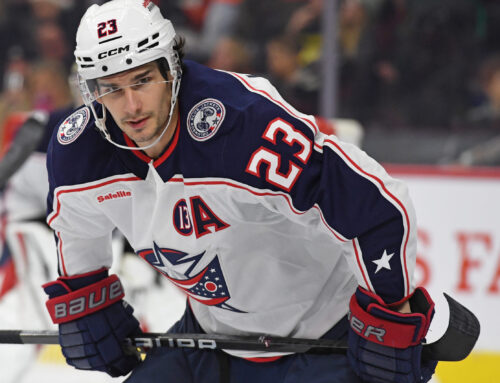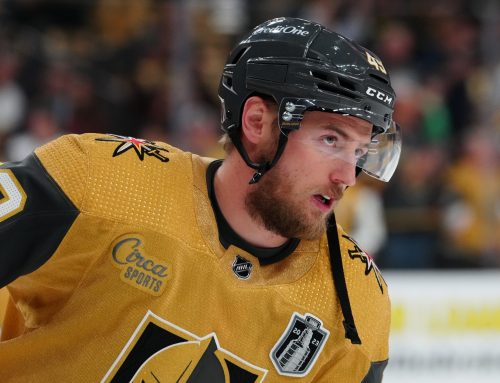The first round of the playoffs is officially wrapped, and it is time to turn our attentions, at long last, to those series. We are going to dive into this extra set of games and see if there is anything to learn about a player's performance. We will go round by round and look at the eliminated teams.
We are starting out west so that means, Nashville, Vegas, Los Angeles, and Winnipeg. For this article we are going to look at these four teams and focus on things that have changed. It is such a small sample size that we are not going to read too much into point paces etc. but instead look at how players were utilized in these win-or-go-home series and if that change resulted in anything different on the score sheet or in the underlying numbers. Doing so might give us a bit of insight into how coaches view certain players and who might be primed for a different role next season compared to this one. This is also the playoffs so to some extent we would assume that a team's top players see a bit of an increase while some depth players might fall off a bit.
Caveat time for all of these first-round exits. They all lost. In the first round. That means small sample sizes of course, but it also means that what the team/coach did didn't really work so there might be less motivation to build on it for next year.
And now on to the process.
We will be looking at deployment and specifically the percentage of time on the power-play, and total time on ice. We will be using percent as overtime games can add significant time to a player's overall count without changing that player's real deployment opportunity. In order to get this data we will be running a Big Board report for the playoffs and comparing that to a second custom Big Board report for the last two months of the regular season. That comparison will tell us which players have gained or lost time between these two samples. Essentially, we are looking at four data points from two different time periods. We have basic scoring data (points per game, and shots per game), then basic time on ice data (percent of the power-play, and total time on ice).
I want to touch base first in Nashville. They played six games in the losing effort to Vancouver. It is very clear from the data that the top line saw a bigger role. Each of Ryan O'Reilly, Gustav Nyquist, and Filip Forsberg saw a large increase in time on ice. In the realm of two plus minutes a night (three and a half for O'Reilly). Add that to a strong regular season, and the fact that all three are under contract for next season and I think we have a pretty good guess at who will be the top line in Nashville next year. The question mark here is that, unfortunately, all three saw a decrease in the percent share of power-play time and they all struggled to not only score, but shoot as well. They all performed worse, and for the most part much worse in this small sample set than during the end of the regular season – even with more ice time. Given the small number of games though I think we have to guess that the regular season successes would outweigh this series in terms of what a coach would want to do with the top line in the future.
If we move on to Winnipeg, the situation is considerably less clear. Mark Scheifele and Kyle Connor are essentially the only players to see more ice time overall (not too surprising given our earlier observation that a team's big players will get bigger roles), but they are among quite a long list of players who got a smaller share of the team's power-play. In fact, the only eliminated players in the entire Western Conference that saw a statistically significant increase in power-play roles were Vladislav Namestnikov, Nikolaj Ehlers, and Nino Niederreiter (all on Winnipeg). Ehlers also managed this without getting any power-play time at all in game five. Basically, it is all a mess. Kyle Connor shot a bit more and Scheifele did slightly better all around so I guess two good players did slightly better with more time on ice. Shocking, I know. Tyler Toffoli and Sean Monahan are also UFAs so might not be back, but ultimately nothing good came out of this series for Winnipeg on offense.
Honestly, LA is not in much better shape here after this series. Viktor Arvidsson saw some increased time, but he was also injured for a lot of the season (so is maybe not the best example) and is now a UFA. I would be eyeing him for next year if he returns though. Everyone else essentially got worse during this series. Does that make it better or worse that LA has six UFA/RFAs? I am not sure. Know who isn't one of them? Pierre-Luc Dubois. He is signed through 2031. That is significant because even after a pretty poor season he managed to get even worse during this series. Less than 15 minutes a night, less than a shot per game, 26 percent of the team's power-play, and only one point. This stat line looks like a bottom six player the team has no faith in and yet he is anchored to the team for basically forever. Count me very much out on him for next year.
It is really hard to know what to make of Vegas' data. A significant challenge in any analysis is that Mark Stone and Tomas Hertl missed huge chunks of the season but were available for the playoffs. Additionally, they have five forward UFAs they are going to need to manage this offseason. If we restrict ourselves a little to the data in front of us, Stone, Hertl and Jack Eichel saw the largest increases in time on ice – no surprises there. Ivan Barbashev, Michael Amadio, and Pavel Dorofeyev saw the biggest decreases across the board with Amadio also losing out on a significant amount of power-play time as well. That isn't a great vote of confidence for a guy who is a UFA. Jonathan Marchessault and Anthony Mantha also saw big decreases in power-play percentage which certainly had to do with the return of Stone and Hertl. Both Mantha and Marchessault are also UFAs.
All of these players would be potentially interesting if they stay with the team and have the opportunity to line up with Stone, Hertl, or Eichel (caveat being Marchessault as he has been worth it in his own right). But during this playoff series they really did nothing to differentiate themselves, and they weren't really given an opportunity to either. I don't see any of them leading the pack, but would still be interested if one of them stays and gets a decent role next year.
That is all for this week.
Do your part to support organizations working to make hockey for everyone.





 ANA
ANA CAR
CAR TOR
TOR VAN
VAN PIT
PIT MIN
MIN S.J
S.J WSH
WSH
